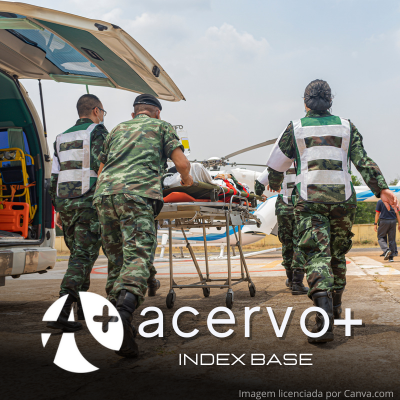Enfermagem militar: a importância no enfrentamento de grandes tragédias
##plugins.themes.bootstrap3.article.main##
Resumo
Objetivo: Identificar na produção científica internacional fatores de relevância acerca da importância da enfermagem militar frente a grandes tragédias. Métodos: Trata-se de uma revisão sistemática da literatura, de abordagem quantitativa e caráter descritivo, registrada na Base Internacional Prospero (CRD42023440317), realizada na base de dados (PubMed), tendo as pesquisas realizadas pelos Medical Subject Headings (MESH): military nursing; military nursing AND military nursing/history; military health AND military nursing e military nursing AND disasters. Para a construção do artigo utilizou-se o roteiro/método PRISMA. No início das pesquisas foram encontrados 1.128 artigos sobre o tema e após a leitura e aplicação dos critérios de exclusão, foram selecionados apenas 28, excluindo 1.100 artigos. Resultados: Evidencia-se que desde o início de guerras e catástrofes, a enfermagem militar está presente, mostrando a necessidade da assistência em cenários de crise, resultando em uma necessidade de adaptação em situações de contrariedade. Considerações finais: Deve-se priorizar o apoio psicológico a estes profissionais antes de enfrentarem situações complexas, já que oferece um risco elevado à saúde mental e provável risco a sua integridade física, por estarem inseridos em contextos de estresse.
##plugins.themes.bootstrap3.article.details##
Copyright © | Todos os direitos reservados.
A revista detém os direitos autorais exclusivos de publicação deste artigo nos termos da lei 9610/98.
Reprodução parcial
É livre o uso de partes do texto, figuras e questionário do artigo, sendo obrigatória a citação dos autores e revista.
Reprodução total
É expressamente proibida, devendo ser autorizada pela revista.
Referências
2. ANDERS RL. What can we learn from U.S. military nursing and COVID-19? Nursing Inquiry, 2020; 27(4): 12384.
3. BITENCOURT JVOV, et al. Nurses' protagonism in the structuring and management of a specific unit for covid-19, Texto contexto - enferm., 2020; 29: 20200213.
4. BORGES FES, et al. Risk factors for Burnout Syndrome in health professionals during the COVID-19 pandemic, Rev. Enferm. Atual In Derme, 2021; 95(33): 21006.
5. BORGES LL, et al. Military Nursing in “Operation Return to Brazil”: aeromedical evacuation in the coronavirus pandemic, Rev Bras Enferm., 2020; 73(2): 20200297.
6. BRASIL. 2021. O Exército Brasileiro na Segunda Guerra Mundial. Disponível em: http ://www.eb.mil.br/exercitobrasileirop_p_id=101&p_p_lifecycle=0&p_p_state=maximized&p_p_mode=view&_101_
struts_action=/asset_publisherview_content&_101_assetEntryId=1556825&_101_type=content&_101_urlTitle
=o-exercito-brasileiro-na-segunda-guerramundial&inheritRedirect=true. Acessado em: 15 de novembro de 2024.
7. CARVALHO YM. Do velho ao novo: a revisão de literatura como método de fazer ciência, Revista Thema, 2020; 16(4): 913-28.
8. DORNELES AJA, et al. Prevalence of Burnout in Brazilian Military Nursing Personnel in Rio Grande Do Sul, Reme Revista Mineira de Enfermagem, 2018; 22:1–7.
9. DORNELES AJA, et al. Sociodemographic and occupational aspects associated with burnout in military nursing workers, Rev Bras Enferm., 2020; 73(2): 20180350.
10. GÓIS ARS e BARBOSA PFC. Social representations about nursing during the covid-19 pandemic, Av. enferm, 2020; 38(1): 21-31.
11. HATZFELD JJ e JENNINGS B. Twenty-five years of the TriService Nursing Research Program: Standing on the shoulders of giants, Nursing Outlook, 2017; 65(5): 1-3.
12. KING CHC e TALBOT LA. COVID-19: Military nurses leading innovation through research, clinical care, education and collaboration, Mil Med., 2021; 186 (12 - 2): 1–3.
13. LOSCHI M. Desastres naturais: 59,4% dos municípios não têm plano de gestão de riscos, Agência IBGE Notícias, 2018.
14. MAIA MFRC. 2021. Ações coordenadas no âmbito do Ministério da Defesa para o treinamento de profissionais de saúde contra a Covid-19. Disponível em: https ://bdex.eb.mil.br/jspui/bitstream/123456789/9751/1/MT_Maj%20Maia.pdf.
15. MELO AG, et al. Burnout Syndrome in critical areas Nursing workers, RSD, 2021; 10(4): 7110413935.
16. MODESTO JG, et al. Professional burnout in times of a pandemic and its repercussions for the worker, RP, 2020; 21(2): 376-91.
17. OBLEA PN, et al. Evaluation of the Clinical Nurse Transition Program at US Army Hospitals, Mil Med., 2019; 184(11-12): 914-921.
18. PEREIRA CAR, et al. Institutional strategies to prevent violence in nursing work: an integrative review, Rev Bras Enferm, 2019; 72(4): 1052-60.
19. PEREIRA LG, et al. Assistência de enfermagem em situações de desastres ambientais, Revista Multidisciplinar do Nordeste Mineiro, 2019; 2: 2.
20. PIUBELLO SMN e PEREIRA JFG. Nursing research in Brazil in the context of the COVID-19 pandemic: an integrative review, RSD, 2022; 11(5): 52411528476.
21. POLAKIEWICZ R. The entry of nursing professionals into the military forces, PEBMED, 2021.
22. RAMBAUSK D. A importância do Hospital de Campanha para as forças militares, RCEsSEx, 2019; 2(2): 78-3.
23. REIS JBABS, et al. Military nursing in coping with COVID-19 in indigenous communities, Revista Recien, 2021; 11(34): 318-23.
24. SANTOS LN, et al. Quality of life of military firefighters working in operational and administrative services, Rev Enferm UFSM, 2018; 8(4): 674-87.
25. SEGEV R. From civil service to military service: what led policymakers to withdraw nursing care from Israeli defense force (DF) field units and return it later? J Health Policy Res, 2019; 9(1): 1.
26. STANTON M, et al. Reintegration Issues of Military Nurses: A Focus Group Approach, Best Pract Ment Health, 2017; 13(1): 1-19.
27. TALBOT LA, et al. History of the Military Nurse Corps and the 1918 Influenza Pandemic: Lessons for the 2019 Coronavírus Pandemic, Mil Med, 2021; 186(1-2): 27-32.
28. WANZER L, et al. Impact of the clinical nurse specialist in transforming military health care from the bedside to the battlefield, Enfermeira Clin Spec, 2019; 33(6): 247-249.
29. WOOLLISCROFT JO. Innovation in response to the COVID-19 pandemic crisis, Acad Med, 2020; 95(8): 1140-2.

